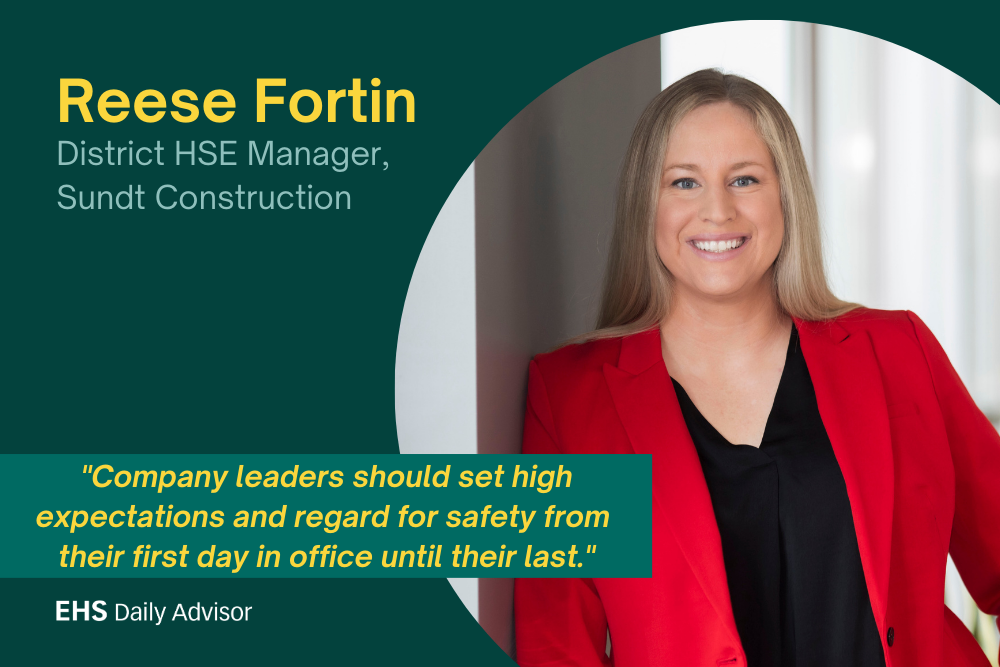Since graduating from Fresno State in 2007 with a bachelor’s degree in safety, Reese Fortin has dedicated her career to engaging, mentoring, and inspiring people to truly value safety. Her diverse experience spans several industries such as manufacturing, healthcare, and construction. She has led dozens of safety professionals and hundreds of construction projects from California to Texas. Reese is a long-time member of the American Society of Safety Professionals and is an active participant in national and local AGC safety programs.
Currently, Reese guides teams constructing building projects in the southwest region and is a key player in managing corporate safety policies and initiatives as a District HSE Manager for Sundt Construction, where she has been a proud employee owner for nearly five years. According to Reese, their biggest safety challenge is to Stop the STCKY (S#*! That Can Kill You) across the construction industry.
For our latest Faces of EHS profile, we sat down with Reese to discuss how she got her start in the industry, management’s role and contribution to safety culture, and learning from near misses while avoiding the STCKY.
Q: How did you get your start in the field?
I switched majors from construction management to safety in my sophomore year in college after learning how well safety fit my life’s purpose and values. Before graduating, I had completed two internships and had a full-time job waiting for me in the manufacturing industry.
Q: Who has been your biggest influence in the industry?
Craft workers—the men and women who are tasked with building our great nation’s projects—have been my biggest influence by spending time with them, learning about their work, and seeking solutions to their problems.
Q: What’s your best mistake and what did you learn from it?
I once worked for a company that preached about how much they valued safety. Instead, they were quick to knee jerk, blame, and even hide incidents. That experience taught me to properly vet out my employers and even visit their facilities before signing on.
Q: What’s your favorite and least favorite part about working in the industry? Would you change anything?
My favorite thing about working in the safety industry is helping people. It really energizes me when I assist in finding a solution or innovation that enhances our ability to work safely. I also appreciate how our industry is open to sharing wisdom (per the industry mantra of “there are no trade secrets in safety”).
Q: What are your thoughts on safety culture? How can company leaders make safety a value within their organization?
There are many components that make up an organization’s safety culture, but the most important are those involving management. Company leaders should set high expectations and regard for safety from their first day in office until their last. Leaders should be aligned on their core beliefs surrounding safety while they consistently engage in and hold teams accountable for specific safety actions that are in line with measurable results.
Q: What safety concerns or issues do you think need more prioritization in EHS programs?
EHS programs need to focus more on the prevention of/learning from STCKY/high-potential near misses where controls were lacking. Many organizations are focused on the actual outcome of incidents and are missing the boat by failing to learn from their near miss incidents.
Q: What will be the impact of Environmental, Social, and Governance (ESG) principles on the EHS industry?
ESG principles elevate psychological safety in the workplace, therefore positively impacting our EHS industry’s work. Due to the success of EHS programs and planning, ESG programs will likely be modeled after them just like Quality has done.
Q: How will new safety technologies influence the work being done by EHS professionals?
As data gets easier to capture, trend, and report, EHS professionals will become more empowered leaders and educated decision makers—ultimately protecting more worker’s lives! By taking advantage of new technology, professionals could spend less time messing with data and slide shows and more time interfacing with frontline workers.
Q: What are you most proud of?
I am most proud of my contributions to our Stop the STCKY Program. I assisted our corporate director of HSE in authoring our white paper on the matter while participating with our corporate safety team in the development of our beliefs, actions, and results. Also, I took the lead in developing our safety app used for conducting STCKY Walks (inspections), incident reporting, and more—it is neat how a tool that I helped build is used by over 1,000 people to protect our workforce. Now that we have embedded STCKY at Sundt, I get to share our program and progress with the industry at frequent industry events, conferences, etc.
Q: Do you have any advice for people entering the profession?
This is a very rewarding profession where you will be able to help thousands of people get home safely to their families every day!


